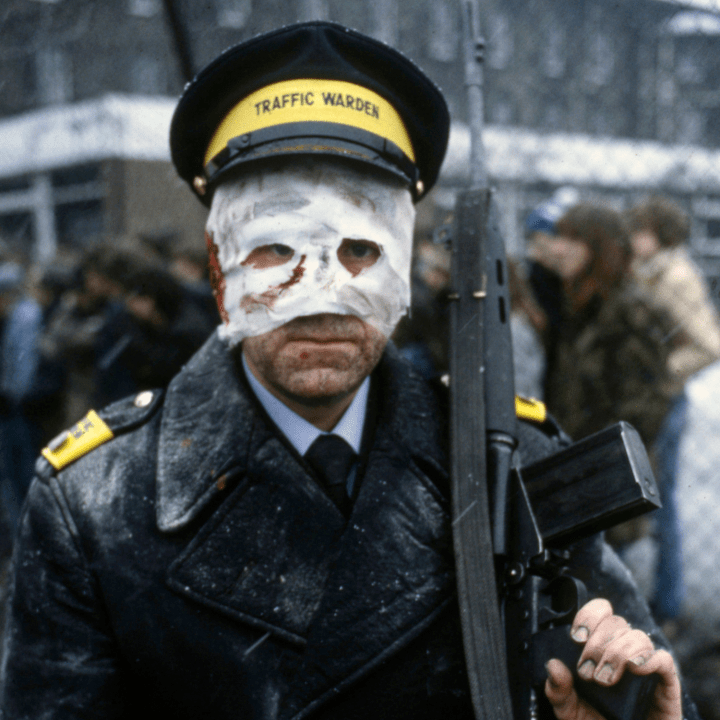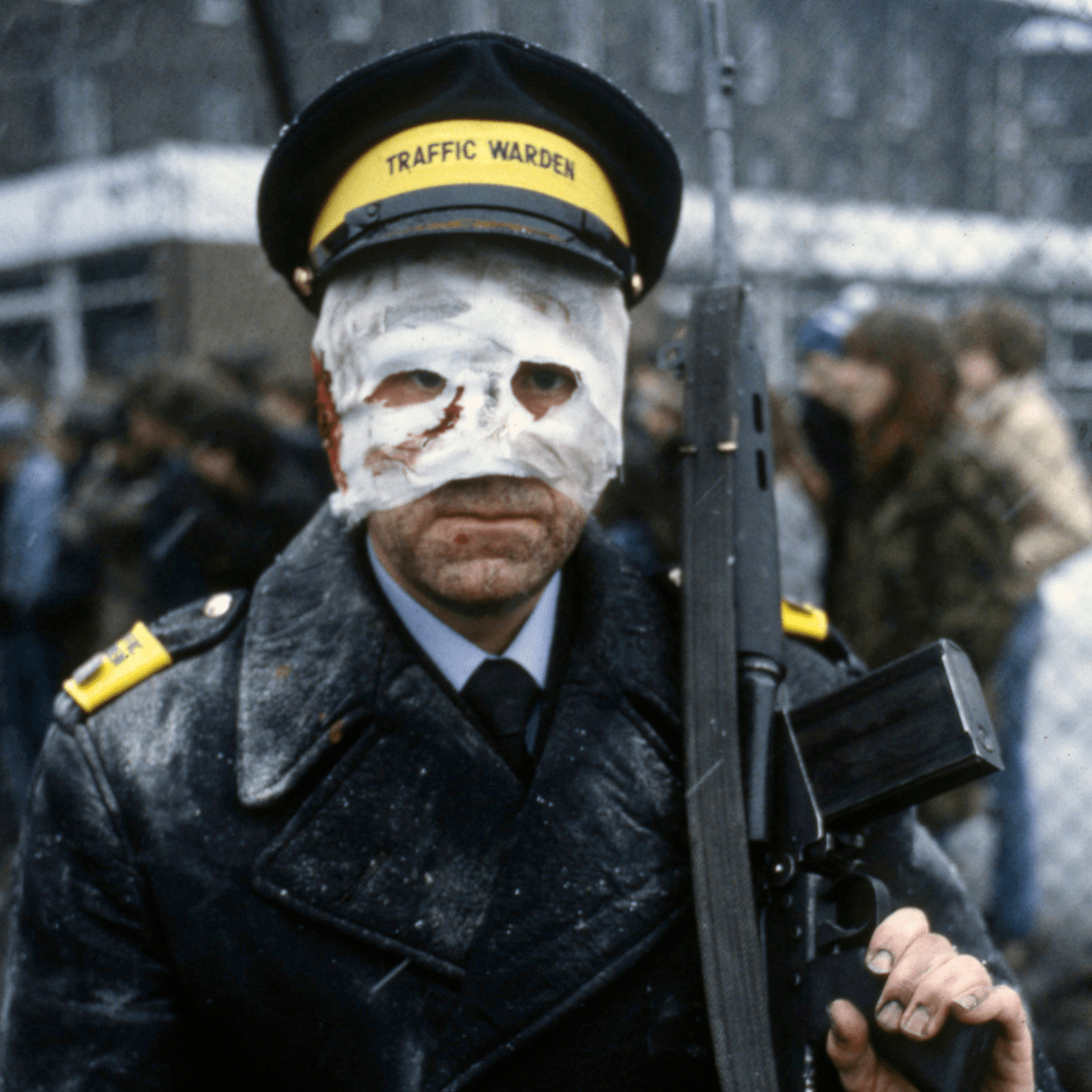
Chas Newkey-Burden has narrated this article for you to listen to.
I was 11 years old when I saw the mushroom cloud go up but this wasn’t Hiroshima or Nagasaki in the 1940s – it was Sheffield in the 1980s.
I was one of nearly seven million people who sat down on the evening of 23 September 1984 to watch a BBC drama called Threads, written by Barry Hines. For many viewers, choosing to watch this film about a nuclear attack on Britain turned out to be an epochal decision.
Threads begins as a kitchen-sink drama, focused around a young couple in Sheffield. The realism of their lives is deftly blended with a documentary narration, making everything seem as real as any fictional drama ever could. The creeping horror of the first half, with the build-up to war played out through news reports in the background of the characters’ ordinary lives, made me want to scream, to make them see the horror that was obviously coming. The tension was built so mercilessly that it became physically painful for the viewer.
Then came the attack itself: first, the blast, then the firestorm and then the radioactive fallout. The fact that it was ordinary British homes and high streets being blown to pieces – including the destruction of British Home Stores and Woolworths – meant Threads packed a particular punch. There were charred corpses, writhing cats and a woman wetting herself, all punctuated by screaming.
Following the attack there’s a swift descent into weapons-grade madness, on both a societal and individual scale. A traumatised mother cradles her dead baby and glares into the viewers’ eyes accusingly; fathers play with the toys that are the only traces of their lost children; limbs are amputated without anaesthetic in a hospital overflowing with blood and agony; and then our heroine is forced to offer sexual favours in return for some dead rats to eat.
The further on from the attack it gets, the less dialogue there is, as the shocked survivors and the children born after the blast are too traumatised to say very much. One member of that new generation falls pregnant after being raped. The film ends with a freeze frame of her face as she is presented with her stillborn baby.
I was paralysed as the closing titles played. Watching Threads had been the most extreme experience of my life up to that point, and it remains the most horrific thing I’ve ever seen on television. In 112 minutes, it blew apart my childhood innocence with as little pity as the missiles offered to the people of Sheffield. The carefree 11-year-old who sat down to watch Threads was transformed overnight into an anxious, questioning and suspicious renegade.
The next day I started to unscrew the living room door to try and build a nuclear shelter. I joined CND – once I’d got through to them, their phone lines jammed with anxious new recruits like me. Nobody could reassure me that what I’d seen on Threads wouldn’t happen in real life. A teacher at my school, which was run by a Vedic cult, told me not to worry because there had already been a nuclear war 5,000 years ago.
When broadcasters discussed Threads on breakfast television, they were palpably stunned by what they’d seen and some viewers argued that it should never have been shown. This was truly edgy broadcasting: Margaret Thatcher didn’t suggest that Threads be shown in secondary schools, as Keir Starmer has with Adolescence; where Mr Bates vs The Post Office angered viewers, Threads traumatised them.
The 1980s are remembered as a period of decadence but it was also a time of nuclear paranoia in popular culture. Radios played atomic hits like ‘Two Tribes’ by Frankie Goes to Hollywood, ‘99 Red Balloons’ by Nena and ‘Dancing With Tears In My Eyes’ by Ultravox. Threads was joined on the small screen by Raymond Briggs’s heart-breaking animation When The Wind Blows and the relatively tame US nuclear war flick The Day After. Martin Amis published Einstein’s Monsters, an underrated collection of short stories about nuclear weapons, and the government published the Protect & Survive leaflet, an overrated collection of tips for how to survive a nuclear war.
Anti-nuclear sentiment surged in the 1980s as the British became increasingly concerned, uncomfortable with Nato’s decision to house cruise missiles in the UK. Anti-nuclear marches attracted hundreds of thousands of protestors and the nuclear threat was as much a part of the public’s conversation as climate change is now. Almost everyone I met on anti-nuclear protests had joined the movement because they had watched Threads.
The film still haunts people to this day, and its importance has led to a recent revival of interest. It was reshown by the BBC for its 40th anniversary last year; a podcast called Atomic Hobo dissected it in a series of fastidiously detailed episodes called Four Minutes of Threads; there’s even a Facebook group, ‘Threads Survivors’, that brings together people whose lives were scarred by the film.
Sheffield: so much to answer for… But if I had to relive that day I wouldn’t hesitate to watch Threads again. I wish more people had. Basic truths about the brutality and darkness of life that can take decades, years or even lifetimes to absorb and understand were drilled into me in less than two hours. So I will always be grateful to the makers of this horrible, horrible film for making me the person I’ve become.
Now there’s a plan for a reboot. The Sheffield-based production team Warp Films plans to turn Threads into a TV series for a new generation. It’s very early days for the project, but there’s already one ominous sign. Emily Feller, Warp’s executive producer, said they ‘imagine highlighting how resilience and connection can offer hope even in the most challenging of times’, allowing them to ‘engage with a modern audience’. Which fails to understand that one of the most powerful elements of Threads was the absence of hope and compromise. The original director Mick Jackson wanted ‘no softening of the facts’, no ‘happy ending’ or ‘false hope’. He set out to ‘scare the living daylights out of people’ with an ‘uncompromising truth’.
Millions die, cities are destroyed and life as we know it is finished for ever, but it’s that absence of hope that is the kick in the gut. When the global tensions first go nuclear, the people of Sheffield are in church, praying for peace. The message is clear: just as your government wouldn’t be able to help you if the bomb dropped, God wouldn’t be able to stop it either. There’s even less room for optimism these days because the destructive power of today’s nuclear weapons dwarfs those of the 1980s, meaning the aftermath of a nuclear war today would be significantly worse than one 40 years ago. Let’s be clear: to inject hope into Threads would be as misguided as it would be to remove hope from It’s A Wonderful Life.
Bringing hope to this hopeless story would feel like a manipulative and condescending tool, and a dilution of the obvious truth that the very best thing to do in a nuclear war is to die as quickly as possible.
The aim of the new version should be the same as the original: to freeze every viewer to the spot so they’ll always remember where they were when they saw the mushroom cloud go up.








Comments